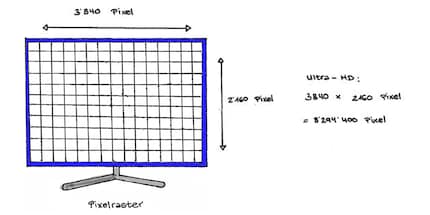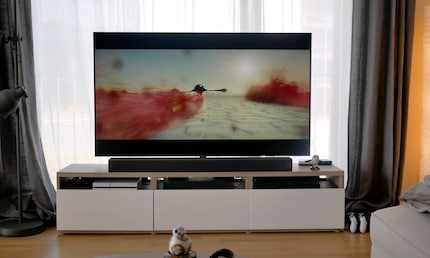
Background information
Ultra HD Premium: What’s the point?
by Luca Fontana

In their bombastic advertising campaigns, manufacturers tend to promise more pixels than there actually are in their 4K TVs. The problem is, nobody seems to mind.
Marketing ploy or scam? Manufacturers are selling us their ultra HD TVs as if they all had 4K definition. That's not true, but that doesn't stop them adding those two little signs which, when they're together, seem to have magical powers.
"4K" is presumably a better seller than the term "ultra HD".
However, manufacturers get away with this big lie, without anyone batting an eyelid. That's probably because most people don't know that 4K is not the same as ultra HD (UHD).
If the shortcuts full HD (FHD), ultra HD (UHD), 4K and 8K mean nothing to you, you should know that they describe the definition of the image. They serve no other purpose than to indicate the number of pixels on the screen. This is important, because pixels reproduce an image and the more there are, the sharper the image will be.
Until a few years ago, a conventional TV offered a definition of 1920 x 1080 pixels, full HD for short. In practice, this means that:
Multiplying these two numbers gives the total number of pixels on the entire screen surface. That is, 2,073,600 pixels for a full HD TV. Today's televisions, mainly from 55 inches upwards, have more than eight million pixels. This is known as ultra HD definition and the screen is made up of 3840 x 2160 pixels.

The following is crucial to our "4K isn't like UHD" debate: Hollywood films don't have the same aspect ratio as TV movies.
Updated 20.11.2018, 9:52am: 4K is used in digital cinemas and generally corresponds - assertions are absolutely impossible because of this damn variable - to a definition of 4096 x 2160 pixels. This gives an aspect ratio slightly greater than 17:9. The image is then adapted to the standard 21:9 cinema format by cropping, to remove part of the images. Thanks to the comments for this clarification!
In the cinema, you watch films in 21:9 whereas TV films are broadcast in 16:9. Simply put: the image is wider in cinema. To avoid cutting films produced for the cinema when they are shown on TV, black bands appear at the top and bottom of the screen. This gives the film a 16:9 format and allows it to play on our TVs.

Hollywood has named its cinema formats according to the number of pixels there are on the horizontal axis of the image. In other words, 2018 x 1080 pixels becomes 2K and 4096 x 2160 becomes 4K. Because the image is wider, it has around 0.6 million more pixels than conventional TV films.
When manufacturers tout 4K definition, they promise a screen with around 8.8 million pixels spread across its entire surface. If we stick to the facts, this is a lie. As TV panels are built to suit the aspect ratio of a 16:9 TV movie, it's therefore physically impossible to have 4K definition, our TVs just aren't wide enough.
So the correct description would be UHD, because that is indeed the designation for this 16:9 definition. And these TVs actually have "only" 8.2 million pixels.
This is important. More pixels on a conventional UHD TV indicates higher density and is a definite advantage. But the number of pixels is exactly that of UHD. However, the manufacturer is promising 4K to its customers, so more than they will actually receive, without them realising it, as few know the difference between 4K and UHD.
The problem: unlike ultra HD or even premium ultra HD, 4K is not regulated by minimum criteria or requirements. Manufacturers can therefore easily slap the 4K claim on their products without risking any concerns.
History repeats itself: 8K TVs are gradually making their way onto the market, but in fact only offer a definition of 7680 x 4320 pixels and are therefore not 8K TVs. So how do you tell? During my research, I came across the terms 'Super Hi-Vision' and 'UHD-2'. I'm going to stick with UHD-2 and add a column to my table.
Will "4K" ever be protected? I don't think so. In any case, until the general public is aware of the differences and encourages manufacturers to stop deceptive marketing, nothing will move.
Update 16.11.2018, 9:04am: You pointed out to me in the comments that digitec.ch also talks about 4K TVs when they're only UHD TVs and you're right!
I write about technology as if it were cinema, and about films as if they were real life. Between bits and blockbusters, I’m after stories that move people, not just generate clicks. And yes – sometimes I listen to film scores louder than I probably should.
Interesting facts about products, behind-the-scenes looks at manufacturers and deep-dives on interesting people.
Show all